Article
Producing Sacred Space in Secular Kitchens:
South Asian Immigrant Women’s Hindu Shrines in American Domestic Architecture
Résumé
Cet article montre par quels processus de production spatiale passent les femmes immigrées hindoues récemment arrivées dans les maisons américaines lorsqu’elles y installent un autel de dévotion, en particulier dans les cuisines. En se concentrant sur l’autel domestique, cet article cherche à comprendre l’architecture vernaculaire sous l’angle du genre, puisque les femmes acquièrent souvent davantage de contrôle sur les objets et les intérieurs domestiques que sur la construction des bâtiments elle-même. J’émets l’hypothèse que la production d’un espace sacré par le biais d’objets domestiques, tels que les autels de dévotion privés, est un processus fluide. L’autel peut facilement changer de place dans la maison et passer d’un endroit à l’autre. Comparativement à la permanence des bâtiments, sa forme modulable peut sembler moins concrètement propice à une analyse architecturale objective, mais cependant je suggère le contraire. La flexibilité inhérente aux processus de production des femmes laisse de la place à une plus ample négociation spatiale et montre la diversité des façons par lesquelles l’architecture domestiques « en dur » est contournée pour satisfaire les besoins religieux des femmes au fil du temps. Plus encore, cet article montre le large et complexe éventail des décisions que les femmes doivent prendre en ce qui concerne les mouvements corporels dans la maison et les pratiques de dévotion, qu’elles réalisent au moyen d’interventions matérielles où l’architecture domestique se fait moins statique et plus dynamique. En décrivant la confrontation de ces femmes à l’architecture domestique au moment où elles viennent d’arriver dans le pays puis, plus tard, en tant que résidentes permanentes, cet article met au premier plan les fortes contributions des femmes à l’architecture au moyen d’objets domestiques qui permettent une approche genrée, et par conséquent moins inclusive, de l’étude de l’espace architectural.
Abstract
This paper demonstrates the processes of spatial production achieved through the setup of a home shrine by newly arrived Hindu immigrant women inside American houses, particularly the kitchens. By focusing on the home shrine, the paper uses a gendered lens through which to understand vernacular architecture, since women often garner greater control over domestic objects and interiors than they do over construction of buildings. I propose that production of sacred space, achieved through domestic objects like home shrines, is a fluid process. Its location in the house can be more easily changed from one place to another. Compared to the permanent construction of buildings, this compliancy of form may appear less concrete for providing objective architectural analysis. However, I suggest that it is the opposite. The flexibility involved in women’s production process makes room for greater spatial negotiation and demonstrates the diversity of ways concrete domestic architecture is maneuvered to satisfy women’s religious needs over time. Further, the paper demonstrates the wide array of complex decisions that women have to make regarding body movements in the house and worship practices, achieved through material intervention, that speak of domestic architecture in less static and more dynamic ways. By tracing women’s experiences with domestic architecture as new arrivals in the country, and later, as permanent residents, the paper foregrounds women’s strong architectural contributions through the use of domestic objects that enable a gendered and consequently a more inclusive approach to the study of architectural space.
1 Shrines are objects intuitively gathered together with the powerful means of meeting the sacred unknown (Turner 1999: 9). This paper discusses newly arrived South Asian Indian Hindu immigrant women’s domestic production of sacred space through the assemblage of objects such as the home shrine. While temporary shrines are set up for a short duration at Hindu festivals, a permanent home shrine is treated with great reverence because it is the place where murtis (small statues) and tasvirs (photos) of household deities are worshipped every day, and where Hindus are able to communicate with divine beings and ancestors, as well as celebrate rites of passage ceremonies and events (Eliade 1961: 107; Mazumdar and Mazumdar 2003: 145). Like kitchen gardens, shrines are also managed and “maintained predominantly almost exclusively— by women” (Turner 1999:11).1
2 My aim in this paper is to demonstrate the gendered processes of spatial production achieved through the setup of the home shrine. Scholarly attention on the built landscape has foregrounded male managed perspectives on public space. Architectural historian Angel Kwolek-Folland has argued for the need to examine artifacts other than buildings as a way to be more inclusive of subject material if the gender of environments is to be understood (1995: 6). By using gender as a category of analysis, and moving our focus to the arrangement of interior spaces, we can expand understandings of vernacular architecture, since women often garner greater control over domestic objects than they do over construction of buildings. By focusing on immigrant women’s domestic objects and spatial experiences in their new American homes, I incorporate a frequently overlooked way of examining architectural space.
3 Permanent home shrines are also particularly important objects to consider and examine because their presence in the house has the ability to shape spatial experience and use in significant ways. One reason for their significance is the Hindu belief in domestic worship. As Neila Seshachari has noted, Hinduism has never been “institutionalized” in the sense that Hindus are not “required” to belong to a specific temple, pledge offerings, or register their children in religious classes. Religion for Hindus is more internalized, something one lives always and observes with rituals whenever possible (1999: 20). Traditional Hindu architecture accommodates the permanent home shrine in a separate worship room. In the absence of a traditional worship room in American homes, the production of sacred space becomes even more relevant. An ethnographic look at this spatial production process is a particularly useful one, since newly arrived immigrant South Asian women, tasked with finding a suitable place to set up the shrine, have no prior experience with American domestic architecture. As such they start afresh and are in ideal positions to shed light on how they spatially experience and build relations with their new domestic surroundings over time.
4 I propose that production of sacred space, achieved through domestic objects like home shrines, is fluid. The location of sacred space within the house can be more easily changed from one place to another. Compared to permanent construction of buildings, this pliability of form may appear less concrete for providing objective architectural analysis. However, I suggest that it is the opposite. The flexibility involved in women’s production processes makes room for greater spatial negotiation, like accommodation of Hindu beliefs in purity and interface with gods, and demonstrates the diversity of ways concrete domestic architecture is maneuvered to satisfy women’s religious needs over time. In addition, it also demonstrates the wide array of complex decisions that women must make regarding body movements in the house and worship practices, achieved through material intervention, that speak of domestic architecture in less static and more dynamic ways.
5 The production process, as I show in this paper, is the result of women’s informal learning, testing, and trying out of the spatial arrangement of American homes with domestic religious practices. Newly arrived women are concerned about dramatic architectural repercussions and therefore approach the production of sacred space cautiously. The sanctity of space is produced temporarily through the setup of the home shrine. If the arrangement is not ideal, the home shrine is removed, and spatial sanctity reconsidered and reproduced until the most appropriate and permanent architectural solution is reached.
6 Women’s experimental processes underscore the way their spatial experiences surrounding domestic objects influence how architectural space gets restructured and used. Within a diasporic context these spatial productions exhibit the different ways that American architectural organization of space inside homes gets reorganized and rearranged. The fact that the women are new immigrants emphasize the importance of spatial production through domestic objects even more since it highlights the way foreign and unfamiliar architectural space is culturally accessed by immigrant women upon entry, and gradually shaped as home owners and permanent residents of the country. As such, this paper foregrounds a gendered perspective through which architectural space can be approached and understood as a process of production and reproduction spatially and over time.
The Ethnographic Context
7 This paper traces women’s production of sacred spaces in rental apartments and later when they move into independent houses. The paper identifies patterns in production of sacred space practiced by a group of women whom I first met in an apartment community in Plainsboro, New Jersey, where I rented a one-bedroom apartment in 2010 to collect dissertation data. The majority of the women cited in this paper were my neighbours and those I met in a children’s park nearby. Most women grew up in small towns in India like Berhampur, Ratlam, Hoshiarpur, and Amravati. Others were from bigger cities like Mumbai, Chennai, and Hyderabad. After marriage to men working in Information Technology (IT) firms as consultants, they moved to the United States when their husbands were offered opportunities to work on short-term projects for American companies. Women were young, between 25-40 years, and had arrived in the United States between 2005-2010 on spousal visas. The majority had children who were between the ages of 3-10 years.
8 This paper draws on data that I collected through sustained ethnography in this community for approximately ten years. After renting for a few years, many of these women received their permanent residency and purchased independent houses in Plainsboro and the neighbouring township of West Windsor. Some research for this paper was also conducted in Salt Lake City, Utah, where I briefly lived, and the city of Bengaluru, India, that I frequently visit. Although India is regionally diverse, with caste hierarchies and class and custom differences across urban and rural divides, the focus of this paper is on shared and popularly practiced religious beliefs among diverse Hindus throughout India. I have drawn attention to regional or caste identities where relevant or mark them in endnotes. The interviews were done primarily in Hindi, the most widely spoken language in India. Throughout this essay, I use some Hindi words and sentences from the interviews and have retained the use of Hindi words for many objects. I provide English translations alongside these Hindi words and phrases when used.
9 A strong emphasis on folk practices is evident throughout this paper. This is because practices surrounding placement, arrangement, decoration, and care of home shrines and family deities rely on knowledge passed down from mothers to daughters in informal domestic settings. Unlike construction of temple buildings that follow guidelines provided in shastras or religious texts written by Brahman men, there are no written rules that one must strictly follow in the arrangement of home shrines (Michell 1977: 62). Spatial uses also differ in major and minor ways from one household to another, containing versions and varieties in placement of home shrines in Hindu homes. While patterns can certainly be discerned where shrines are commonly kept, inbuilt architectural features in American houses are opened to individual interpretations, uses, preferences, and a multiplicity of learned behaviours from previous generations that get spatially expressed in a diversity of ways in new domestic settings.
Spatial Sanctity in Hindu Homes
10 Hindu home shrines, comprising of murtis (small statues) and photos of family gods and ancestors, have traditionally dictated the way Hindu houses are spatially organized. Traditional Hindu architectural norms set aside a separate worship room for the placement of the home shrine to respect the ritual purity of the shrine and shield it from a “host of profane activities that necessarily have to be performed at home” (Sinha 2011: 76). Shampa Majumdar and Sanjoy Majumdar note a “hierarchical spatial arrangement” of Hindu domestic architecture (1993: 42). Rooms inside traditional Hindu houses are ranked in hierarchical order of sacred, semi-sacred, neutral, and profane. After the worship room, the kitchen and the threshold (which marks the division between the sacred and the profane) are considered the second most sacred spaces. The pantry, transitional spaces such as hallways near the worship room, and the dining area, where food is consumed, are considered semi-sacred. Worship rooms are wedged sometimes between the kitchen and the hallway, pantry, or dining area to secure their purity (Fig. 1).
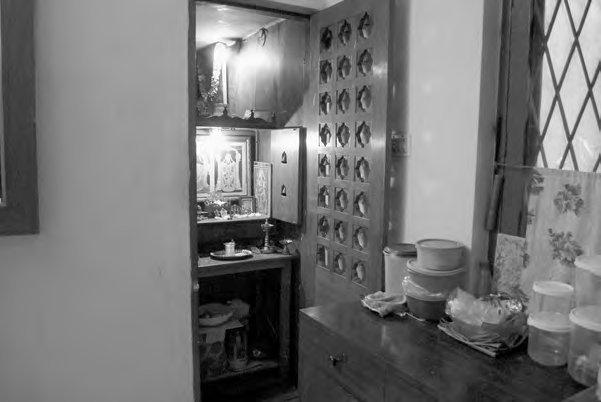 Display large image of Figure 1
Display large image of Figure 1
11 The semi-sacred status of kitchen is elevated further when a worship room is absent in the house. In that case, a worship corner may be integrated in the kitchen. As seen in Fig. 2, this family in Bengaluru, India, created a wall to separate the sacred worship corner from the secular kitchen. As Majumdar and Majumdar note (1993) living areas such as reception rooms, front verandahs, and bedrooms, are considered ritually neutral spaces situated in-betwixt the pure sacred spaces of the puja room and kitchen and the impure spaces of the house. Bathrooms and toilets are considered the most impure of all spaces and are situated in a peripheral location, sometimes independent from the rest of the house. The locational norms dictate the separation and seclusion of the worship room in order to protect its sanctity from defilement through contact with profane spaces, people, activities and behaviours.
 Display large image of Figure 2
Display large image of Figure 2
12 Anthropologist Brenda Beck states that firm rules govern body movements in Hindu homes because people can easily disturb the spatial purity of the house (2005: 2404). The presence of women causes a dichotomous dilemma, since they are integral to home management and the care for home deities, but their bodies are considered inherently impure during menstruation. Sacred space, as Thomas Tweed argues, constitutes the interaction of embodied selves with physical environments (2011: 122). Women’s presence in the temple threatens its purity since menstrual pollution spreads through touch, and infringing the rules of purity offend deities (Fuller 1992: 69-72). The Brahman priestly caste therefore prohibit menstruating women from entering the temple.
13 Women’s need for physical distance from deities during menses poses challenges for Hindus to go to the temple as a family. If any female member has her period, the family declines to visit the temple. This is especially so when daughters in the family reach puberty. The presence of the home shine, I argue, is essential because it enables Hindus to worship as a family. At home, the menstruating female member may either avoid entering the worship room altogether, sit at a distance from the home deities, or avoid touching deities or religious objects and food in the worship room, while being physically present with the family there. While Brahman male-dictated laws can bar women from entering the temple buildings during their menses, they cannot remove women from their own homes.2 While the presence of worship rooms certainly limit the spread of menstrual pollution and satisfy priestly mandates, how women negotiate their menstrual cycles with domestic roles and responsibilities is still at their discretion. A separate worship room in a traditional Hindu home, therefore, plays an important role in managing worship as a family, while maintaining the spatial purity for the family gods in the home shrine.
14 When Hindus move to the United States, the absence of a separate worship room/corner poses an architectural problem and practices surrounding purity have to be negotiated. Without a separate worship room, sacred space has to be produced within available domestic American architecture. The kitchen is popularly picked as the most suitable place to set up the home shrine for a variety of reasons. Firstly, as many scholars have previously noted, the kitchen is designated the second purest room of the house, after the worship room (Majumdar & Majumdar 1993: 42; Ghosh 1995: 41; Srinivas 2002: 376; King 2012: 449). Its purity derives from its close association with food, which is given divine status, and cooking is considered a shudh prakriya, or a pure process. Secondly, kitchens, more than any other room in the house, provide functional versatility in the sense that they are designed with counters and shelves to cook and store food. Chad Randl notes that postwar American kitchens were arranged as “work centers” for washing, cooking, and storage (2014: 74). American kitchens therefore offer a variety of functional parts that give options of where the shrine can be set up and informally tested in relation to preserving the shrine’s purity. Lastly, postwar American kitchens provide the added advantage of being situated in the front and centre of domestic space, rather than hidden in the rear of the house (Cromley 2010: 179). Domestic shrines set up in kitchens are able to provide constant interface with god. Hindus refer to this interface as darshan. Eyes, as scholars have noted, are an important part of the visual interaction with the gods (Babb 1981: 387; Eck 1981: 5-6). Family deities, my informants explained, should be able to see and hear all the problems and tensions of the household so that they can relieve them. Production of sacred space, therefore, does not have to come at the risk of isolating deities in a corner of the house that no one visits throughout the day.
American Kitchens and Sacred Spatial Production
15 Most immigrants on temporary visas rent apartments when they first move to the United States. The standardized kitchens of postwar America provide some basic model of continuous counter tops for food preparation, upper and lower kitchen cabinets for storage, efficient appliances, and a cooking range (Cromley 2010: 177). Since a cooking range clearly cannot be used for the purpose of worship, women turn to kitchen counters, cabinets, and appliances as suitable options for the arrangement of the home shrine.3
16 In some instances, women set up home shrines directly on kitchen counters. Usually a corner of a kitchen counter is chosen for the shrine. However, the limited space of kitchen counters in small apartments proves risky since menstruating women stay in close proximity to the shrine while preparing food. One woman, Rupa, who had set up her shrine in one corner of the kitchen counter, found herself constantly apologizing to her family gods every time her hand accidently touched the shrine during her period. Kitchen counters are therefore often considered too small, open, and exposed for secure setup of the home shrine. Another woman, Mansi, who also placed her shrine in a corner of her kitchen counter decided to buy a mandap, a small temple-shaped house for the gods, to secure them against any defilement during her menses. However, other women I interviewed noted that buying a mandap while on a temporary visa was a hasty financial investment since mandaps are treated with religious sanctity, and cannot be easily disposed. Immigrants arriving on temporary work visas are uncertain of long-term stay in the country and therefore tend to avoid purchases that would be difficult to carry back to India.
17 Compared to kitchen counters, kitchen cabinets provide versatility and variety in setting up the home shine, but pose problems in ritual practice. Lower cabinets are almost always eliminated as suitable choices because women do not want to set up the shrine in a cabinet near impure garbage cans or dishwashers associated with uncleanness.4 However, upper cabinets are not problem-free either. They prevent women from sitting on the mat and offering prayers, which is the more traditional form of domestic worship.5 Even though some devotees are willing to stand and worship, upper cabinets present further challenges due to the shelves they contain. Since home shrines consist of murtis of multiple gods, and women hesitate to put some deities on shelves higher than others, it appears disrespectful to place deities on lower shelves. Storage is also limited in small apartment kitchens and devotees do not want to cram their gods with food items and compromise on the comfort of the deities.
18 Kitchen cabinets, however, present variety in location that prove advantageous. Cabinets that are less convenient for storing daily cooking ingredients and simply too high for women to reach, such as those above refrigerators or microwave ovens, are treated as ideal setups for a variety of reasons. Since these cabinets are generally built without (or with fewer) shelves, egalitarian placement of the murtis becomes possible. Sonali set up her shrine in the cabinet above the built-in microwave. She placed murtis of gods on the higher shelf, while those of dead ancestors (and objects used for worship) on the lower shelf. The height of the cabinet, above her arm’s reach, prevented her from accidently touching the shrine during menses. Also, she could leave the cabinet doors open for constant interface with god, without interfering with efficient access to spaces used for preparation of food. However, one problem with the height of a cabinet is the difficulty of lighting the daily religious lamp called deepak, an intrinsic part of daily Hindu worship. As a solution, Sonali placed a chair at one corner of the kitchen. Instead of lighting the lamp on a daily basis, she lights it every Thursday when she offers prayers to her kuldevta, or primary deity of the family. On a daily basis, she sits on the kitchen floor to worship. But on Thursdays, she stands on the chair to light the lamp and offer her prayers (Fig. 3).
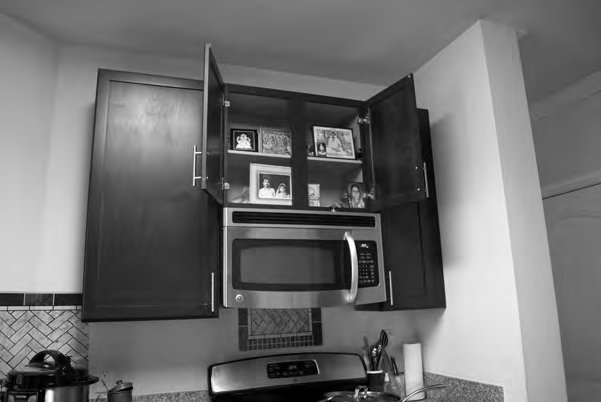 Display large image of Figure 3
Display large image of Figure 3
19 Kitchen appliances are also sometimes considered for the setup of the shrine.6 The flat surfaces of appliances are viewed as convenient platforms for placement of murtis. The presence of the cooking range above the oven eliminates the oven’s surface as an option. Although refrigerator surfaces are rarely ever considered an appropriate option, I found in one instance a woman named Ramya, who had moved to the United States in early 2016, set up her shrine on a small steel plate, placed on top of the refrigerator. She preferred a mobile shrine, which she could bring down and place on the kitchen counter for worship every morning, and then put back on the refrigerator top after worship. She reasoned that the mobility allowed her to keep the shrine out of reach of her three-year son, who did not yet understand the sanctity of the shrine (Fig. 4). However, she found it tiresome to use a chair to bring the shrine down every morning and then put it back up after prayers. The surface of the refrigerator is therefore her temporary solution until her son grows up or she identifies a more convenient location.
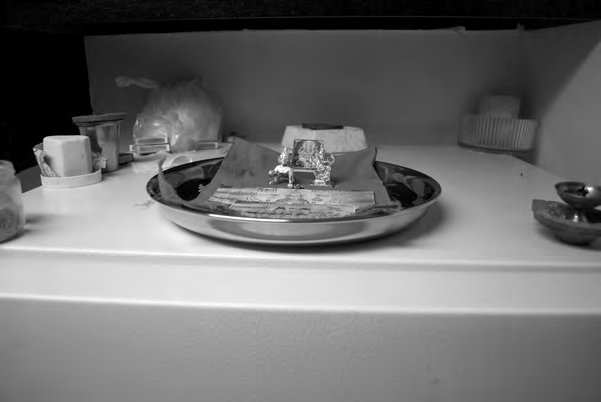 Display large image of Figure 4
Display large image of Figure 4
20 Microwaves provide a more suitable option, but like kitchen counters, they prove risky in small kitchens where menstruating women might accidently touch deities while cooking. One woman, Ritu, who prefers worshipping in a traditional manner sitting on the floor, found a creative way of combining the bulky microwave with a store-bought cabinet. She placed a newly purchased wooden cabinet next to the kitchen counter as a way of extending the kitchen, and she set up her shrine inside the cabinet. Since her microwave is unfitted, she moved its location from the kitchen and set it up on the surface of her newly bought cabinet. This arrangement saved precious kitchen space, without interfering with the sanctity of home shrine. Since her family eat meat infrequently, the microwave over the shrine does not prove a threat since she uses it to heat up mostly vegetarian food. On a daily basis, the cabinet doors are always left open. During her menstrual cycle, or the few times that meat is cooked, she closes the cabinet doors. The setup proves ideal because the family can worship while sitting on a mat on the floor; lighting the religious lamp is not a problem and constant interface with gods is never interrupted. As far as the microwave is concerned, its placement on top of the cabinet does not interfere with daily worship, while its presence in the kitchen continues to be valued for culinary convenience and efficiency (Fig. 5).
 Display large image of Figure 5
Display large image of Figure 5
21 Sonali, Ramya, and Ritu’s shrine setups indicate that apartment kitchens come with architectural limitations for sacred setups. Cabinets are too high, counters are too small, appliances like microwaves are too bulky. If women want to set up the shrine in the kitchen, they must often figure out creative ways to perform ritual practices while continuing to use the kitchen for daily cooking. Extra furniture is frequently used to supplement the spatial deficiencies found in the kitchen. Sonali and Ramya use chairs to access the shrines, while Ritu bought a cabinet and combined her shrine and microwave to save space and worship in a traditional manner on the floor. In all three cases, production of scared space is achieved through creative incorporation of inbuilt provisions with store-bought furniture like chairs or wooden cabinets that enable the American kitchen to satisfy dual purposes as sacred spaces for cooking and family worship. Without these incorporative practices, women like Rupa find themselves constantly apologizing to their family gods who are setup directly on the kitchen counter. Although Mansi did buy a mandap, it was viewed as unwise on a short term visa. Secular furniture that can be bought for a cheap price and can be easily disposed is generally preferred as a temporary solution.
Open Concept Floor Plans and the Food Axis
22 In spite of the sacred status that kitchens enjoy, some women avoid setting up the home shrine in the kitchen. They argue that the presence of the shrine in the kitchen increases the sanctity of the kitchen too much. As a result, religious custom of not entering the worship room while menstruating cannot be ignored. Instead of the kitchen, many prefer the dining area as a suitable alternative because it falls in the same “food axis” as the kitchen. Food axis refers to the kitchen, where food is cooked, and the dining area, where food is consumed. In postwar American homes, the food axis combines the kitchen and the dining area into one open floorplan (Cromley 2010: 179). As a result of this open spatial configuration, women do not feel their movements into the dining area as limiting as entrance into a separate room like the kitchen.7
23 Nirmala, for instance, observed the manner and location that her friends keep the home shrine, and bought a bookshelf to set up her shrine in one corner of the dining area. She placed the murtis on the top shelf of the bookshelf to safeguard them from the reach of her three-year old daughter, and used the lower shelves for religious items to perform her daily worship. To draw attention to the sanctified space she used colourful paper to ornament the shrine with a decorative roof resembling a Hindu temple. The absence of walls in an open concept floor plan leave the room open for new interpretations of how sacred-spatial configuration within the home should be realized. As an area where food is consumed and is less labour intensive than the kitchen, dining areas provide open and empty corners that can be used to set up the home shrine. Women can serve food to family in the dining room, while completely avoiding physical proximity to the home shrine during menstruation (Fig. 6).
 Display large image of Figure 6
Display large image of Figure 6
24 When women first arrive in the U.S., new architectural amenities often lead them to try spaces like inbuilt linen cabinets in hallways for the setup of the shrine. However, linen-cabinets can prove problematic. Although they are publicly accessible in the hallways and appear protected against menstrual touch, they are, as Parul experienced, not accessible during menses. Parul, for instance, first setup her shrine in the linen-cabinet in the hallway outside her bedroom. But linen cabinets, she found, had too many shelves. She set up the shrine on two shelves of the linen cabinet and stored other home items in the other shelves. But during menses, she could not touch any other items in the cabinet. If she needed anything from the cabinet, she had to wait for her husband to come home in the evening, and ask him to remove the item for her. Due to the inherent inconvenience, she later decided to change the location. She bought a small cabinet and set up the shrine on the surface of the cabinet. She placed the cabinet near the corner of the dining table and avoided that corner entirely during her period.
25 Like linen cabinets, other domestic amenities like pantries also prove ill-suited for the shrine. In spite of being in the kitchen and having doors that can be closed during menstrual cycles, women rarely pick inbuilt pantries as a suitable choice for the setup of the home shrine. The reason is the same as linen cabinets—too many shelves. If the shrine is set up on one of the shelves in the pantry, women cannot access any items on the other shelves in the pantry during their period.8 Since pantries are used to store daily kitchen ingredients, women need regular access to them. Kritika, however, did set up her shrine on the bottom floor of her pantry. On the two shelves above the shrine, she placed religious items for the performance of the worship. She began using the remaining shelves to store non-perishable items like packets of Maggi noodles or extra lentils that she did not need for daily cooking and could avoid removing from the shelves during her menstrual cycle.9 By setting up the shrine in the pantry, she compromised on storage space and used the pantry as a shrine much more than she used it as a pantry to store food (Fig. 7).
 Display large image of Figure 7
Display large image of Figure 7
26 As discussed in these examples, women architecturally adapt and amend features through spatially experiencing them. Like Parul, women often set up the shrine in one location of the apartment, but later, as they became more accustomed to living in the apartment, change the location closer to the food axis. Other times, women like Kritika convert architectural amenities such as pantries to serve purposes of housing the shrine. The kitchen and the related food axis frequently satisfy sacred needs compared to the rest of the house that proves limiting for a variety of reasons.
27 Spaces in the apartment are commonly divided into public living spaces and private sleeping spaces. A young couple’s bedroom is never chosen because a shrine’s presence makes it embarrassing and disrespectful to engage in sex. The master bedroom is, therefore, almost always eliminated. If the family live in a two-bedroom apartment, a second bedroom provides a suitable alternative. However, as the experience of Neeta shows, bedrooms provide limited spatial control in relation to the placement of the bed. Neeta set up her family’s shrine in the closet of the second bedroom. Her husband often invites friends from India visiting the U.S. on business to stay with them. Since her guests consist mostly of males, they would not threaten the purity of the shrine in the same way as a woman might. However, Neeta was not happy with her choice of setting up the shrine in the closet. The design of the room worried her because it did not let her control the placement of the bed. She felt that her guests’ feet often faced her deities, which she found disrespectful. Neeta, for the time being, left the shrine in the second bedroom as she contemplated alternative spaces to relocate it. The kitchen was an option, but in her personal case it proved difficult. Neeta grew up in a Brahman Punjabi family. Like most Brahmans, her family does not eat meat. However, she had a love marriage with a Bengali man who ate meat.10 Even though she refrains from eating meat herself, Neeta cooks it regularly for her husband. Since her kitchen is a place where she cooks meat frequently, she was reluctant to set up her shrine in the kitchen. Neeta’s example shows the many complex cultural and spatial factors women must negotiate as they seek functional locations for domestic shrines.
28 The second bedroom is also deemed inappropriate if children are nearing puberty. As one woman explained, “right now my shrine is in my son’s bedroom closet. But he is getting older and young boys start doing bad things alone in the bedroom, so now I am thinking of changing the location of the shrine.” Although this woman did not clearly state where she was planning on relocating the shrine, the apartment provided few options.
29 In one instance, I found a shrine set up in a corner of the living room. Aparna noted that her shrine’s location in a corner next to the family television provided sustained interface with the family gods since everyone’s eyes are directed for long hours at the television. However, Aparna’s location of the shrine in the living room was a rare occurrence. Most women explained that living rooms pose problems because menses are private and no one can tell if a female guest is having her period. Kitchen space is much more negotiable because the lady of the house can control physical distance from the shrine during menses. The public nature (and therefore limited in control) of the living room space, compared to the kitchen, influences women’s preference for the shrine’s location generally in the food axis.
30 Production of sacred space in the apartments is often the result of spatial experience with domestic architecture and design. Like women who set up shrines in the kitchen, women’s experience with linen closets, pantries, and closets show that inbuilt architectural features do not always work for domestic religious needs. There are either too many shelves, limited control over furniture arrangement in bedrooms where people sleep, or too much public access in the living room. The limited options outside the food axis often locate and relocate shrines in or near kitchens. Material intervention is often required to acculturate the food axis to the religious needs of the new inhabitants. Women like Nirmala observe the setup of shrines in their friends’ homes, and locate them near their dining areas. When inbuilt architectural features like linen closets prove inconvenient, women like Parul buy cabinets and relocate the shrine’s location in the food axis. Other times, women like Kritika convert architectural features such as pantries into fulltime shrines by storing non-essential food items in shelves not occupied by the shrine and its related objects. Production of sacred space is thus spatially expressed through testing and trying domestic space with the experiences of its inhabitants. Although the majority of the women I interviewed found the food axis as the most suitable set up for the shrine, there are always exceptions like Aparna’s home shrine that is displayed in the living room next to the television because it increases interface with gods, or Neeta’s shrine arranged in the closet of the second bedroom because she could not resolve the vegetarian/non-vegetarian conflict in her kitchen. Production of sacred space is therefore also a very personalized process.
The Food Axis and Festivals in Single Family Houses
31 Scholars have noted the importance that immigrants give to home ownership because homes serve as sources of investment, security, and permanency, with a commitment to the new country (see Agrawal 2006: 118-20). For new immigrants from India, purchase of the house is frequently tied to their visa status. Very rarely do Indians purchase houses while on short-term visas due to fears of visa statuses being revoked or the threat of deportation if they lose their jobs. Most consider it prudent to wait for permanent residency before risking large financial investments. However permanent residency is a long bureaucratic process that can involve several years. Few immigrants, therefore, move out of rental apartments until permanent residency is achieved.
32 Once permanent residency is achieved, houses are purchased very quickly. Decisions over where to set up the home shrine are made immediately after moving into the new house.11 Architectural familiarity achieved through long-term occupancy in apartments largely influences the architectural setup of home shrines in independent houses. Since open concept floor plans of independent houses resemble the apartments, women, now familiar with the layout, place the home shrine directly in the food axis.12 Rather than the kitchen, the dining areas are preferred due to the multiplicity of dining rooms in the house. Although the house has one kitchen, there are commonly two dining areas, informal and formal.
33 Ritu, for instance, set up her home shrine in a cabinet under a microwave and near the kitchen in her apartment. When she bought a house, she located her shrine in the informal dining area. The proximity of informal dining to her kitchen resembled the setup she had in her rented apartment. However, this time, instead of setting up the shrine directly on low tables or cabinets, Ritu purchased a large mandap to place the family gods. Her wooden mandap provided extra separation of family gods from the secular activities of the kitchen, and at the same time allowed the gods’ presence in the centre of domestic life. Instead of a corner, she decided to devote the entire informal dining area to the home shrine. Her decision was influenced by multiple factors. Firstly, she wanted to give her deities their own space. Secondly, the large space enabled her to worship in the traditional manner of sitting on the floor. Finally, the window next to the shrine increased the pleasure of daily worship. By looking out of the window after prayers, she found herself sitting longer with the divine. Ritu also celebrates many Hindu festivals. Some of these festivals are also accompanied by large gatherings. The presence of invited friends and family during celebrations lead to greater decoration and elaboration of sacred space. The informal dining area, left entirely dedicated to the gods and their worship, increases the sanctity of the space. Furthermore, the presence of the large wooden mandap in place of a dining table establishes an appearance of a worship room without the need for walls (Fig. 8).
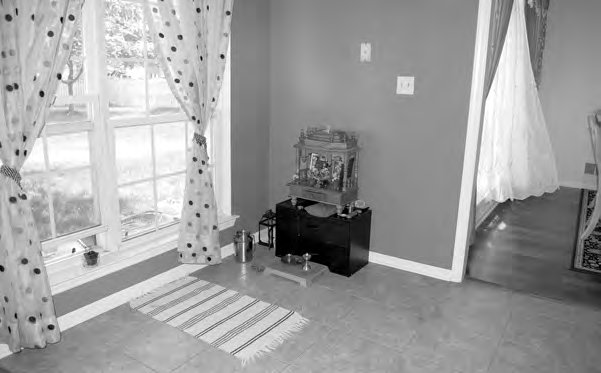 Display large image of Figure 8
Display large image of Figure 8
34 Instead of informal dining areas, women like Suparna prefer setting up the home shrine in the formal dining area. After purchasing a house, Suparna found herself with far more options to place the shrine. At first Suparna, now with a bigger sized kitchen, decided to put the shrine in one of her kitchen cabinets. But she found the kitchen to be a very busy place as she and her mother-in-law prepped special dishes, or her adolescent children opened and closed cabinets to look for snacks. Suparna therefore decided to change the location of the shrine. Instead of buying a mandap, she bought an ornamental cabinet and placed it at one corner of the dining area that opened into the formal living room. She set up her murtis for worship on the top shelf of the cabinet and objects for worship on the shelves below. The cabinet doors, kept frequently open for regular access, and closed for protection during menses or when guests socialized in the adjoining living room, provided convenient flexibility (Fig. 9).
 Display large image of Figure 9
Display large image of Figure 9
35 Although Suparna has a formal dining table, her family rarely eat there, preferring instead to consume meals at the smaller table in the informal dining area. The placement of the shrine in one corner of the formal dining area therefore ensures that the room is used more regularly. In addition, it also enables more peaceful worship away from what she, like many women, described as noises of roj ka dining. Women often refer to informal dining areas as roj ka or “daily dining.” Spatially wedged between the kitchen and the family room, informal dining areas are inescapable from routinized use at the centre of domestic activities and as such carry the noises of the entire house.13 Formal living or dining rooms/areas, more cut off from the kitchen and informal dining, offer opportunities to worship with less disturbances and noise. While limited space in apartments leave women with fewer choices, single-family homes open up more spatial options to worship in ways that one desires. At religious events and festivals, Suparna also prepares for more elaborate worship by setting up a small temporary shrine on a religious table, called chaurang, at one side of the dining area. This allows the whole family consisting of two children, parents, and elderly mother-in-law, to comfortably sit on the floor and worship together. Suparna’s choice of the formal dining area allows her to spatially integrate and separate the shrine from daily activities of the house (Fig. 10).
 Display large image of Figure 10
Display large image of Figure 10
36 In another instance, Pritha converted her entire formal living room into a permanent worship room. Instead of buying furniture, she bought a large wooden mandap. In the mandap, she set up her murtis and photos. A larger framed photo of a saint was also displayed on a chair. A religious mat (aasan) was placed in front of the shrine for worship. The choice of making the living room into a worship room is, as described earlier, an unusual choice since living rooms are considered too public. However, after purchase of her house, Pritha complained of having too much space. The formal dining room and the formal living room were treated as “extras,” since Pritha felt that informal dining and family rooms were sufficient for daily living.14 The family therefore eats at the informal dining table or on the couch in front of the television in the family room. Family members tend to walk past the formal living room and into the family room or kitchen after getting home from work or school. The open concept floor plan of the formal living room and formal dining area are rarely used. Pritha decided to set up a formal dining table in the formal dining area to serve buffet style dinners to guests at parties. Since her family and friends are vegetarian, she does not have to worry about disturbing the purity of her family gods by setting up the shrine in the formal living area. By converting her formal living room into a worship room, Pritha ensures daily use and sustained interface with gods every time family members enter or leave the house (Fig. 11).
 Display large image of Figure 11
Display large image of Figure 11
37 Although Pritha’s decision of converting the formal living room into a permanent worship room is a rare choice, I found formal living rooms often converted into temporary festival rooms. These festival rooms are sometimes left unfurnished. At domestic festivals, many of which tend to be female-only gatherings, the empty living room is used to accommodate large groups of invited women. Gayatri, a south Indian Tamil woman celebrates the nine-day festival of Navratri by keeping a kolu shrine every year. These kolu shrines are temporary shrines set up for the worship of goddesses. Gayatri invites her female friends to see the kolu and offer prayers to the goddesses. Since women sit in the traditional manner, on the floor, on bamboo mats, Gayatri does not have to investment in any furniture. After the festival she removes the kolu shrine and rolls up the mats. For the rest of the year, she uses the empty room for her bharatnatyam classes, a classical dance form of south India, that she teaches from home. The location of the living room at the front and close to the entrance of the house works out conveniently for her classes as students enter and exit the house without the need to pass through the house completely.
38 This location of the room in the front of the house also works out during the Navratri festival, when large groups of women gather there. Gayatri sets up the kolu shrine in the middle of the room, against the wall. She makes a religious drawing called kolam in front of the shrine. The kolu room, separated and in front of the house, allows all women—whether menstruating or not—to participate in the kolu event without threatening spatial purity. Practices surrounding menstruation, I noted, are more severely observed in relation to the family gods in the permanent home shrine compared to temporary shrine festivals. Food cooked in the adjoining kitchen is brought out to women, seated on the bamboo mats, on plastic or paper plates by the hostess. Menstruating women leave after eating and spending time with other women, without entering any inner rooms like the kitchen where the family gods are generally placed. Spatial purity of the home shrine can therefore be maintained without limiting the participation of all female friends (Fig. 12).
 Display large image of Figure 12
Display large image of Figure 12
39 Although I often found kolu shrines set up in finished basements, Gayatri’s formal dining room festival setup works out much better. Basement shrines, as some informants explained, split the festival throughout the house. Women walk down to see the shrine, and then walk up to eat. Formal dining rooms converted into festival rooms pack the festival into one room. It enables easy access to the kitchen, where food is cooked and served to women seated in the kolu room, without the need to walk up and down any staircase either for the host or guests.
40 The production of sacred space in the examples discussed is the result of both spatial familiarity and a variety of new options. Like apartments, women continue to test spatial options before deciding where they want to set up the shrine. Ritu, familiar with the kitchen setup in her apartment, decided to replicate the shrine’s arrangement in a new home by placing the mandap in the informal dining area that is closest to the kitchen. Suparna first set up her shrine in the kitchen, but later, after experiencing her new home, decided to move the shrine to the formal dining area. Pritha, unhappy with all the extra space to furnish, but rarely use, converted her formal living room into a worship room to utilize the space more constructively and regularly. Gayatri, on the other hand, set up her shrine in the kitchen but found new ways of using the formal dining room as a classroom and festival room. In all cases, women adapt domestic space to satisfy religious needs in personal and cultural ways. Security of permanent stay in the country enables the purchase of expensive objects such as mandaps and ornamental cabinets that sanctify space in more permanent ways, without limiting women’s options or spatial control as home owners, in case they wish to change the location.
Architectural Constructions for Permanent Shrine Placement
41 In spite of the multiple room options, a kitchen’s religious attachment to spatial-sacred purity leads many women to continue setting up home shrines in the kitchen in independent houses. I almost never found the home shrine set up directly in the family room. Unlike a kitchen with cabinets, the family room, although at the centre of domestic life, lacks any inbuilt architectural features like cabinets to provide protection from women accidently touching the home shrine while they are menstruating.
42 Just like the apartment, the variety of options in the kitchen such as counters, cabinets, and appliances makes it possible to carve out a special place for the home shrine that integrates and separates it from domestic activities going on around it. While counter space is preciously saved in apartment kitchens, the larger size of kitchens in independent houses provides more options. Gayatri, for instance, set up her shrine on the counter above the oven. Ovens in American kitchens are generally located under the cooking range. But this is not the case in Gayatri’s house where the oven is located under a kitchen counter next to the refrigerator. While she made abundant use of in-built kitchen appliances such as the dishwasher, microwave and refrigerator, she found herself rarely using the oven. She commonly uses it to store raw or cooked food and utensils, since Indian curries, dry vegetables, and lentils are either boiled or fried, but hardly ever baked. Gayatri therefore took advantage of the open counter space above the oven to set up her shrine. She also uses the inbuilt cabinets above the shrine to store objects used for religious worship as well as plastic plates and forks that she does not need daily. The family, being vegetarian, keeps the family gods safe from meat or menstrual pollution since the shrine counter is set away from the bigger kitchen counters that Gayatri uses for daily preparation of food. In addition to murtis and photos, Gayatri makes regular kolams with rice paste to increase the sanctity of the space, thus carving out a separate worship corner for her shrine in her kitchen (Fig. 13).
 Display large image of Figure 13
Display large image of Figure 13
43 The larger size of kitchens in independent houses also provides more cabinet space. Although a sink under a window is popular, it is not so in many homes I observed where kitchens are without any windows.15 Instead, continuous cabinets line the kitchen. Vibha preferred setting up her shrine in one of the kitchen cabinets above the sink. This location of the cabinet was convenient for the setup of the home shrine because unlike cabinets close to the cooking range or counters used for cutting and preparation of food, cabinets over sinks do not require women to reach out for any spices or ingredients. Setting up the home shrine above the sink, used for washing vegetables before cooking or cleaning utensils after meals, does not interfere with preparation of food. Since home ownership provides more control over domestic space, Vibha enhanced the spatial purity of the home shrine through a small architectural addition. She installed an extra bulb inside the cabinet because she does not want to leave gods in the darkness of the cabinet. When she is not menstruating, she leaves the doors open so that the sacred area stays continuously lit and the physical presence of the home shrine is sustained throughout the day (Fig. 14).
 Display large image of Figure 14
Display large image of Figure 14
44 Often houses with windows above the sink have cabinet spaces on either side of the window. Sushila placed her home shrine next to the window above the sink. Instead of keeping the cabinet doors open, she decided to remove the cabinet doors entirely because the family is vegetarian and the shrine is therefore protected against the impurity of meat. Also, due to the height of the cabinet she cannot accidently touch the shrine during her menstrual cycle. Like Vibha, she installed extra lighting in the home shrine to establish and increase the shrine’s sanctity from the rest of the kitchen. On the counter below, she placed two market-bought appliances, one Instant Pot and one rice cooker that although mobile, could be semi-permanently left in their places on the kitchen counter. Since the appliances are used to cook vegetarian food, they do not disturb the purity of the shrine, but retain their functional value in the kitchen. The kitchen appliances on the counter and the shrine in the cabinet above, separated and integrated with the rest of the kitchen, serve both her sacred and secular needs (Fig. 15).
 Display large image of Figure 15
Display large image of Figure 15
45 Sometimes women make more architectural changes to the kitchen. Shikha, in Salt Lake City, Utah, removed one section of wooden cabinets in her kitchen and replaced them with glass ones so that she could close the cabinet doors during her period without eliminating the interface with her gods. She also wanted to remove the entire kitchen counter under the cabinets, and make the whole section into a worship space, so that she could spread an aasan and pray in a traditional manner of sitting on the floor. However, the contractor who came to replace the wooden cabinet doors with the glass ones advised her against it. He indicated that if she ever wanted to sell the house in the future, she might not be able to find the same design of kitchen counter, and this would adversely affect the resale value of the house. Shikha therefore decided to remove the shelves from the cabinets to make space to accommodate her large mandap. She also used the counter space below the glass cabinet to place additional murtis and objects of worship to expand her shrine without removing the kitchen counter entirely. She noted that her decision not to remove the kitchen counter certainly affects her manner of worship because she must continue offering her prayers standing up rather than sitting on the floor. But the architectural replacement of wooden cabinet doors with glass ones enables her to maintain constant interface with gods, without hurting the resale value of her house (Fig. 16).
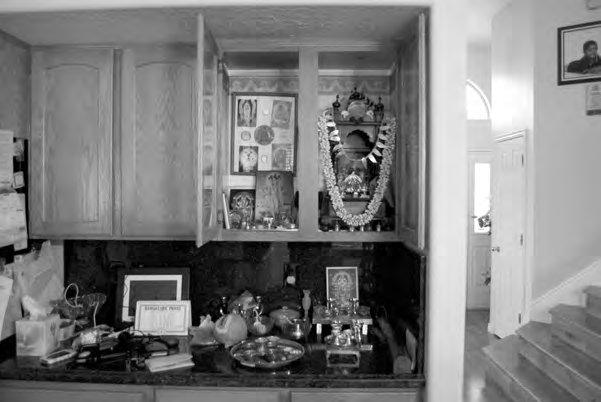 Display large image of Figure 16
Display large image of Figure 16
46 In central New Jersey, where there is a large South Asian population, women feel confident making architectural changes on a larger scale without worrying about how it might affect the resale value of the house because they reason that their houses are likely to be bought by other South Asians. In fact, the presence of an already carved out sacred space for the home shrine could improve rather than hurt the resale value of their houses. In the case of one townhome that I visited, the owners removed a section of the fireplace brick wall to create a small space. When I asked Anju, who was renting the townhome from fellow Indians, about this she did not know why the owners had done so. She placed her home shrine inside the fireplace because she assumed that it was for the setup of the shrine. She found the nook convenient, since she and her husband never used the fireplace anyway. The absence of fireplaces in hot countries like India make fireplaces unfamiliar and potentially dangerous architectural novelties that South Asians are generally wary of using. For Anju, the presence of the brick fireplace in the centre of the family room proved ideal in setting up the home shrine in a place of prominence, and was a welcomed architectural change in a place where owners and tenants are likely to be Indian (Fig. 17).
 Display large image of Figure 17
Display large image of Figure 17
47 Many women I met refrained from any constructions or architectural adaptions and adjustments if they could find a home that provided a separate room for the home shrine. A separate room allows individual worship and social celebration in the same space without concerns over moving furniture out or leaving a room unfurnished. Often Hindus in the market to purchase a house request realtors to find them a house with a small room. Instead of describing it as a worship room, women request to see houses with a large pantry or sunroom. Vathsala pointed out that formal living rooms are too large. Traditional worship rooms are small in size to accommodate spatial needs of gods and not humans. Since humans are mobile, they need larger rooms, but that is not the case with gods who due to human devotion and religious desires are permanently stapit (seated) in the house. To give deities a room meant for human living appears disrespectful to divine needs.
48 Vathsala intentionally bought a house with a sunroom that she in turn made into a worship room. Although she would have preferred her sunroom attached to the family room, rather than the formal living room, she was willing to compromise on location to get a suitable room that satisfied the size requirements. She placed the permanent home shrine in one corner of the sunroom and deliberately left the rest of the room vacant so that she could set up her temporary kolu shrine. Her decision for setting up her home shrine in a corner of the room was to ensure that it is not moved or disturbed when she sets up her temporary kolu shrine. Vathsala further indicated that placing the home shrine in a corner allows menstruating women to participate in the kolu festival while avoiding the home deities. At the same time, the family gods could witness and participate in the festival without leaving their place of prominence in the house (Fig. 18).
 Display large image of Figure 18
Display large image of Figure 18
49 Women who desire a worship room indicated that construction of a worship room is more feasible if the house is a new one under construction. When Supraja and her husband decided to buy a house in Central New Jersey, they were fortunate to find a house that was still being constructed. Supraja requested the builder to integrate a worship room into the house’s floorplan. Her primary concern was that no part of the toilet or bathroom pipes should pass through the walls of her worship room. The only space possible was the spot where a staircase and a mudroom should have gone. Supraja did not desire a mudroom; neither did she care for a large laundry room. The builder redirected the staircase, got rid of the mudroom, reduced the size of the laundry area, and gave Supraja the worship room with doors that she desired. Since the worship room is adjacent to the family room, she hoped that it would not be a problem when selling the house. The worship room could be described as a study to an average American buyer (Fig. 19).
 Display large image of Figure 19
Display large image of Figure 19
50 Unlike rental apartments where women use chairs, cabinets, or bookshelves to successfully integrate the home shrine and worship practices in American kitchens, home ownership provides women with greater architectural authority. While women continue to set up home shrines inside or on in-built architectural features like kitchen counters and cabinets, they can also control how they manage architectural intervention in setting up shrines in more personalized ways that satisfy religious norms without limiting culinary conveniences. While women like Gayatri take advantage of kitchen designs that open more counter space over the oven, others like Vibha and Sushila make minor changes like putting a light bulb inside kitchen cabinets to give deities light or removing the doors of kitchen cabinets entirely to sustain interface with gods. In still other cases women like Supraja and Shikha make more drastic architectural alterations by asking builders to customize the construction of a separate worship room or replace a kitchen’s wooden cabinet doors with glass ones. On the other hand, women like Vathsala prefer to buy houses with sunrooms that can be converted into worship rooms to avoid the hassle of customizing new shrine rooms.
51 Production of sacred space, whether customized with minor or major architectural changes or factored into house buying practices, suggests confidence in architectural knowledge. Women gain this knowledge through spatial experiences, especially of the food axis where the need for these modifications tend to be most commonly expressed. Combined with greater architectural authority as home owners, this knowledge influences new ways of approaching and altering American architecture.
Conclusion
52 This study of interior domestic space puts women at the forefront of architectural decision making. As this paper demonstrates, architectural space examined from the perspective of women tells a story not so much of spatial construction but one of spatial production. In the case of South Asian immigrant women’s arrangement of Hindu domestic shrines, spatial production draws attention to kitchens and the food axis because these are spaces that these women know best. In rental apartments, women use chairs or store bought cabinets to set up their shrines in small kitchens. As home owners, they feel more secure, and make minor or major architectural maneuvers to place shrines in personally and culturally satisfying ways. In a large number of cases, women make no architectural changes to their houses. Rather, they restructure and subvert the way pre-designed domestic spaces are meant to be used by converting informal dining, formal living, or sun rooms into shrine rooms/corners. The diversity of spatial expressions evident throughout these examples foreground women’s strong architectural contributions through the use of everyday domestic and religious objects. As such, they reveal the potential of more gendered and inclusive approaches to the study of vernacular architecture.